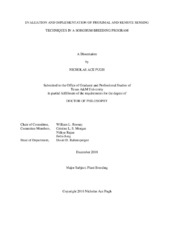| dc.description.abstract | Plant breeders must improve the efficiency of their programs to meet the needs of a rising world population and a rapidly changing climate. Proximal and remote sensing technologies stand as an attractive option for breeders, as they can help to alleviate the phenotyping bottleneck in most programs. Sorghum (Sorghum bicolor, L. Moench) stands as an excellent crop for researchers to test these technologies. Traits such as biomass yield, plant height, and anthracnose resistance are all important traits to sorghum breeders. In addition, spatial variability is often of chief concern in sorghum breeding trials. For biomass yield and plant height, we utilized Canopy Volume/Canopy Coverage estimates and structure-from-motion (SfM)-derived plant height estimates, respectively. It was determined that Canopy Volume is effective at teasing out the most genotypic variation, while minimizing error, when compared to Canopy Coverage as an estimate of biomass. Additionally, the ninety-fifth percentile (P95) of SfM height estimate was shown to be more strongly correlated with ground-truth estimates of plant height. For estimation of spatial variability, we utilized soil apparent electrical conductivity (ECa) grids to test three different linear models for their ability to account for spatial autocorrelation in various trials via a Moran’s I test. We found that in most situations it is unnecessary to use blocking or soil ECva grids, but that in situations where it is necessary there is usually a superior choice. Thus, it is probably best to use both methods and determine which is the best for each situation by finding which model removes spatial autocorrelation. Finally, we tested normalized difference vegetation index (NDVI) for its ability to estimate the incidence and severity of anthracnose (Colletotrichum sublineola) disease in a sorghum breeding population. We find that NDVI is highly effective at delineating genotypic variation for anthracnose resistance later in the season but is inferior to ground-truth methods early on. There are many other traits and aspects of
sorghum breeding that have yet to be tested, but these examples serve as an indicator that remote and proximal sensing will be an incredibly valuable tool in the future. | en |


